Insect & Disease Conditions Update
Forest & Shade Tree - Insect & Disease Conditions for Maine
May 20, 2015
Note: A pdf version of this bulletin with higher resolution photos will be posted to the Conditions Report Index Page.
May brings with it much to celebrate and observe. Foremost in our minds this week are the observance of Arbor Week in Maine (Yes, we get a whole week, while the rest of the nation settles for a day!) and the national observance of Emerald Ash Borer Awareness Week.
On Monday the kick-off of Arbor Week included recognition of Kennebunkport arborist Bob Palmer with the Frank Knight Community Service Award. In addition, 18 municipalities were recognized for their commitment to community trees through participation in the Tree City USA program. The event also included information on community ash trees and the threat from emerald ash borer. Seedlings for observation of Arbor Week were donated by Cedarworks of Rockland, Irving Woodlands LLC, and Central Maine Power Co. They are available for local Arbor Week events, school programs, and more. If you would like to hand out seedlings at your event, please contact Jan Santerre at 287-4987 or jan.santerre@maine.gov. To learn more about these events, visit their website and check out their latest newsletter.
National Emerald Ash Borer Awareness Week is always celebrated the week prior to Memorial Day weekend—the big kickoff to camping (and firewood travel) season across the nation. It is set at this time to remind people that moving firewood long distances is no longer an acceptable practice. In many cases, it is illegal. Even though people are often aware of the reasons behind not moving firewood, many believe that their firewood is safe, so not part of the problem (Snell et al., 2014*). Emerald ash borer is a great example, but only one of many, of why you should “buy it where you burn it.” We know that in Michigan, about 75% of outlying infestations of emerald ash borer were started because of the movement of infested firewood. Others among the many in the ranks of forest pests that can move readily on firewood include oak wilt, brown spruce longhorned beetle, Asian longhorned beetle, winter moth and gypsy moth. During this National Emerald Ash Borer Awareness Week we ask that you join us in the effort to educate others about the reasons (18 million acres of forest and so much more) why leaving your firewood at home is so important. We invite you to visit our firewood page for more information.
Finally, we would be remiss to ignore the observation that this has been a dry, warm month to-date for most of the Northeast, with the exception in Maine of Northern Penobscot/Southern Aroostook Counties. This follows a dry April. Continued dry weather could lead to relief from fungal needle and shoot diseases of conifers that have been epidemic in Maine in recent years. However, from an overall tree health perspective it is not positive. Consider supplemental watering of recently transplanted trees and shrubs during periods of dry weather. You can find more information on regional climate conditions at the Northeast Regional Climate Center website. The Morton Arboretum has a useful information page on providing the right amount of water for trees and shrubs.
* From: Campers and Invasive Forest Pests in Northern New England.
Insects
 Browntail Moth (Euproctis chrysorrhoea) – The caterpillars of the browntail moth are actively feeding now. If your oaks, apple, cherry, birch and other hardwoods are being defoliated check and see what kind of caterpillar is feeding. It could be browntail, winter moth, eastern tent caterpillar, fall cankerworm, Bruce spanworm or maybe something else! Browntail is the only one of these that will cause a rash. They are hairy, dark brown with two white stripes and two orange dots.
If insecticide applications are warranted then they should be made during the month of May by a registered pesticide applicator. There are specific regulations for controlling browntail moth near coastal waters. Be sure to check on the current Board of Pesticide Control regulations before treatment (Chapter 29, Section5).
We have a list of licensed pesticide applicators that treat browntail moth and other pests of trees and shrubs available on-line or by request.
Bruce Spanworm (Operophtera bruceata) – Bruce spanworm is a native forest defoliator that is very closely related to the invasive winter moth (O. brumata)—in fact, they are so closely related, that they successfully interbreed. Occasionally, Bruce spanworm populations cause significant defoliation. Hannah Broadley, a PhD student at the University of Massachusetts, is looking for areas where Bruce spanworm is causing noticeable defoliation. These looper caterpillars will eat a variety of hardwood trees and shrubs, but seem to prefer maple and poplar. Time is running short for Hannah’s collections—she wants caterpillars, and soon they’ll be pupae—but some of our readers may have just the populations she is looking for. How can you tell? Look for Swiss cheese-like holes on expanded leaves of maples and other hardwoods and dozens of “inchworm” caterpillars. Check to see if you’re in winter-moth territory (If you are, it doesn’t mean you don’t have Bruce spanworm, but winter moth is a possibility.) and check in with the Lab.
Christmas Tree Pests – The season to treat for balsam twig aphid is upon us in southern Maine. In far northern Maine you may still have time to treat for balsam shootboring sawfly, but that window will soon close. If you have damaging levels of balsam gall midge, you need to monitor your fir for appropriate development to time treatment of the pest. For some growers treatments will need to occur before the first of June. See the attached May Guide for Pest Management for more information
|
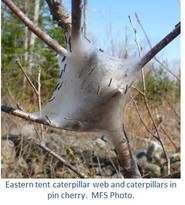 Eastern Tent Caterpillar (Malacosoma americanum) – Populations of eastern tent caterpillar seem to be slightly higher than normal. In the Capitol Region, it is not uncommon to see roadside cherry or crab apple trees festooned with several webs. Most trees defoliated by this pest will refoliate later in the season with little notable impact. If webs are considered unsightly in ornamental trees, they can be removed in the evenings by winding them around a forked stick and soaking the resulting mess in a bucket of soapy water. Similar tactics or registered insecticides can be used on fruit-bearing trees. Early intervention will reduce the amount of defoliation. Seabrooke Leckie has an informative blog-post on the natural history of this insect.
Emerald Ash Borer (Agrilus planipennis) – All trap trees girdled in the spring of 2014 were negative for signs of emerald ash borer (EAB). We are starting to girdle trees again this year to continue monitoring for EAB. If you have an ash tree of any species over four inches diameter at 4.5 feet that you would be willing to sacrifice as a trap tree, please email Patti Roberts at patti.roberts@maine.gov with the subject line Trap Tree. The Maine Forest Service and its partners are also placing over 700 purple traps throughout the state this year to monitor for EAB.
This time of year the native six-spotted tiger beetle adult has made its first appearance across the state. These blocky, long-legged, metallic green beetles are often mistaken for EAB (for a picture of this beneficial insect, visit our purple trap page). Adult EAB have not emerged yet in this region. The Northeast Regional Climate Center includes Concord, NH on their webpage Growing Degree Day Accumulations to support the tracking of emerald ash borer. EAB adults emerge at 550 GDD or when the black locust bloom (Source: UNH Cooperative extension pest alert, May 19, 2015). We have yet to reach that in Maine.
Ground-Nesting Bees – Beginning in very early spring, solitary ground-dwelling bees emerge and become active. When they first emerge they are usually very active, with much flying around, mating, exploration and nest-building. As people increase their yard-work activities, they begin to notice the bees. All the activity by bees can look rather frightening. However solitary bees (one nest for each female, although you may have many nests in one area) are generally non-aggressive and must be severely harassed before they sting. The males often look aggressive while they fly around searching for a mate, but they can’t sting at all. This heightened activity persists for only a week or two, and then the bees are almost unnoticeable. Ground nesting bees are valuable pollinators.
Hemlock Woolly Adelgid (Adelges tsugae) – A landowner in Woolwich (Lincoln County) reported hemlock woolly adelgid (HWA) from his woodlot situated at about the north-south mid-point of town near the Kennebec River. The infestation was not readily apparent in understory trees, but obvious in the crowns of harvested co-dominant hemlock. If you are harvesting hemlock you are encouraged to examine branches of felled trees for signs of HWA and elongate hemlock scale (EHS). They are both more readily detectable from canopy samples than from the ground. HWA is currently known to be established in forest locations from Kittery to Camden. Further inland we expect it to be found first along rivers, which serve as corridors for some of its important vectors (birds) and provide a warmer winter climate. If you have any doubt whether what you are looking at is HWA (or EHS), bag a sample and put it in the mail to the lab. Usually all that is required to ship it is a standard-sized envelope and a single stamp.
Remember, this time of year HWA can be picked up on clothing, machinery and other items and moved to new locations.
|
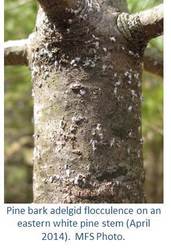 Pine Bark Adelgid (Pineus strobi) – You have the opportunity to help further research into silver flies (Leucopis spp.) as biological controls for hemlock woolly adelgid. Nathan Havill is a research scientist with the US Forest Service, exploring adelgid biological controls among other projects. Each spring Nathan renews his request for samples of live adelgid to screen for predators and sample genetic material. This year he is specifically looking for pine bark adelgid, which is found on the branch tips, branches and trunks of eastern white pine. Detailed collecting and submission information will be provided upon request: e-mail or call Allison Kanoti (allison.m.kanoti@maine.gov or (207) 287-3147).
|
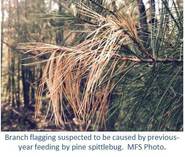 Pine Spittlebug (Aphrophora cribrata) – Flagging of eastern white pine branch tips assumed to be associated with previous-year feeding damage by pine spittlebug was noted in Augusta (Kennebec County). The needles of affected shoots have a wilted, bleached-orange appearance. Upon dissection, a necrotic spot consistent with spittlebug feeding injury can be found inside the twig at the junction of live and dead tissue.
Two other common causes of branch tip flagging in eastern white pine include pine leaf adelgid and Pityophthorus sp. shoot borer. With the former, great numbers of dead adelgid nymphs may be visible, with aid of a hand lens, on the flagged shoot. Twigs attacked by the latter will be hollow in the center.
You may note in the fact sheet that the scientific name of this pest is given as A. parallella. This is likely an error, as described by Hamilton in The Spittlebugs of Canada, Homoptera Cercopidae (1982). On page 42 he states, “Records of ‘Aphrophora parallela’ feeding on pines refer to cribrata.”
|
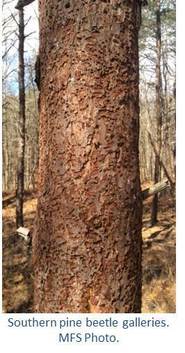 Southern Pine Beetle (Dendroctonus frontalis) – In April, crews from the Forest Inventory & Analysis unit travelled to Long Island, New York as part of the Northeast Forest Fire Compact, to assist the New York State Department of Environmental Conservation (DEC) with efforts to control a recently detected outbreak of southern pine beetle. They surveyed and delimited infestations on DEC properties in Suffolk County. Crews worked directly with DEC staff, learning how to identify southern pine beetle damage as opposed to damage caused by other beetles, and becoming acquainted with the data collection protocols and technology.
The infestation was first detected on Long Island in October of 2014. It is believed to have come from New Jersey with recent large storms. Treatment began in February 2015 on the two largest damage areas, but the true extent of the infestation is not known.
Southern pine beetle was also recently confirmed in Connecticut. This may eventually become an issue in hard pines in Maine, especially in the sand plains in the southern part of the state. It is not expected to have a significant impact on the white pine resource.
In addition to DEC staff, there were forest pest crews from New Hampshire and Nova Scotia. As well as learning about southern pine beetle and its potential movement into Maine, it was a great opportunity to learn about pest issues impacting neighbors and the monitoring and control activities that they are conducting.
|
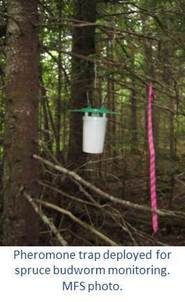 Spruce Budworm (Choristoneura fumiferana) – This notorious native insect is not defoliating fir and spruce trees in Maine - yet. However, our native population is starting to grow, and Quebec has a large spruce budworm infestation that may spill over into Maine in future years to augment our home-grown situation. Spruce budworm populations cycle with the spruce/fir forest every 40+/- years as the forest starts to mature and then becomes over-mature. Maine is just moving into a period of maturing spruce/fir and the budworm population is starting to increase.
Based on predictions that budworm will become a problem in the next few years the Maine Forest Service is coordinating a statewide spruce budworm monitoring program. For the second year, large landowners and managers are helping by deploying pheromone traps in almost every township across the northern half of the state. There will be over 1200 traps monitoring more than 400 sites. The wide coverage will give us an idea of where and when the budworm populations are increasing in Maine. The monitoring program will continue each year to aid in making management decisions for protecting the spruce/fir resource.
|
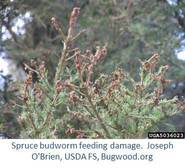 In northern Maine keep an eye out for defoliation on fir (the favored host of spruce budworm) and spruce. They are messy feeders that web old needles together. Emerging second instar spruce budworm larvae start feeding as needle miners primarily on last year’s needles before moving to the buds on fir. Then larvae feed on the buds, then on new foliage and finally go back to feeding on older foliage. If you notice this damage on fir and spruce, take photos and/or send a sample to the Lab. In July, report any flights of small brown moths. If possible catch some and send them to the Lab.
Ticks – May is Lyme Disease Awareness Month and we want to remind you the importance of daily tick checks and encourage the “inspect and protect” prevention strategy.
Ticks are primarily active in warmer months. Lyme disease is a bacterial infection that is caused by a bite from an infected deer tick (Ixodes scapularis). In Maine, Lyme disease is most common in adults 65 and over and children between the ages of 5 and 15, but anyone can get the disease. Individuals who work or play outside are more likely to be exposed to ticks. The most common and visible symptom of Lyme disease is a red bulls-eye rash that grows and appears within 3-30 days of exposure. Other symptoms may include fevers, and joint or muscle pain.
The easiest way to avoid the Lyme and other tick-borne diseases is prevention, using “No Ticks 4 ME”:
- Use caution in tick infested areas
- Wear protective clothing
- Use an EPA approved repellant
- Perform daily tick checks after any outdoor activity
For more information on Lyme disease visit Maine CDC. The University of Maine Cooperative Extension has a lot of information about ticks, and instructions for submitting ticks you find for identification. New this year, the Pest Management Office is providing identification as a free service.
|
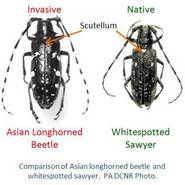 Whitespotted Sawyer (Monochamus scutellatus) – The black and white adult females of whitespotted sawyer beetles will soon be out around the state. This native woodboring beetle infests dead and dying conifers. The larvae of this and other native longhorned beetles are responsible for the chewing noises that come from cut softwood logs left in sunny locations.
The adult female whitespotted sawyers are responsible for many reported sightings of the invasive Asian longhorned beetle (ALB) across the Northeast. From now until about July 4th, one can say almost without looking that it is not the ALB. Their adults begin to emerge later in the growing season, in Massachusetts usually around Independence Day. The adults look quite similar to our native longhorned beetle, but there are some key differences that most people can readily see. The scutellum of whitespotted sawyers is covered in fine white scales, creating a heart-shaped white spot in the top-center of the wing covers beneath the pronotum. On ALB, the same area is black. The whitespotted sawyer has a bronzy tinge to the black body color—the ALB is patent leather, glossy, true black. If you have any doubt, please take a picture or submit a sample. With this pest, early detection can make a huge difference! ALB has not yet been found in Maine.
|
 Winter Moth (Operophtera brumata) – Winter moth larvae started emerging the first week of May – a week later than in 2014 - and are feeding on oak, apple, maple, birch, blueberry and other deciduous trees and shrubs. As of this week larval counts in Harpswell, Cape Elizabeth, Kittery and South Portland indicate that the early November snow and cold reduced the populations significantly compared to last year and populations are especially down from 2013. We hope defoliation will be lighter in most locations.
Winter moth larvae are small green inchworms that hatch in early spring and initially put out silk to ‘balloon’ on the wind dispersing to more hosts. They then feed first in the buds, webbing the new leaves together. As the leaves expand, the feeding damage takes on the appearance of Swiss cheese and then the larvae consume all the foliage as the infestation progresses. Larvae will move to other hosts as they consume all the foliage on a tree. Feeding is completed in early June when the larvae ‘silk down’ to the ground where they form cocoons and stay all summer and fall. The adults emerge from the ground in late November and December.
The Maine Forest Service released the parasitic flies, Cyzenis albicans, for the third year in conjunction with the University of Massachusetts and funded by the USDA. This year 2,000 flies were released on Peaks Island, part of Portland, on May 15th. On the same day 1,000 flies were released in Cape Elizabeth to augment the release there in 2013.
The first question people always ask about this biocontrol is, “Will the flies bother anything else (like people)?” The answer is no. This species was released in Nova Scotia in the 1960’s, brought the winter moth population under control and there have been no adverse effects in the intervening 50 years. Flies were also released in British Columbia, again with no impacts on other insects or people. The flies are very closely tied to the winter moth life cycle and need winter moth to survive. There will always be some winter moth around now that they have become established in Maine, but hopefully the flies, once established, will do their job and bring the winter moth population under control.
It will be years before we see the results of the biocontrol effort as it takes time for the flies to become acclimated to a new location and build up their population to a high enough level that it will have a noticeable impact on the winter moth population. In the meantime people will see defoliation on hardwood trees and shrubs in May. With luck this will not have an adverse effect on the trees before the parasite population catches up to the winter moth population and brings them into balance in Maine.
Critical Information:
A concern is that the winter moth may be spreading further. Larvae disperse to some extent by ballooning to nearby locations. But humans are probably a far greater factor in moving this insect than natural spread. Winter moth cocoons are in the soil from late May until November. Any landscape plants moved from infested areas can have winter moth in the soil. Don’t move plants from areas infested with winter moth. This includes tree saplings that are dug in the spring as they may have eggs and/or larvae on them.
Please report any hardwood defoliation this spring so that we can check out which insect is feeding on the trees. Winter moth particularly favors oak, but feed on a wide range of other hardwoods as well. The feeding makes leaves looks like Swiss cheese.
|
Diseases and Injuries
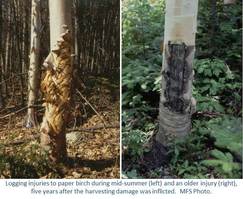 Damage to Residual Trees during Spring Harvesting Operations: A Caution - Harvesting is a fundamental activity of forestry which provides a wide variety of wood products and economic value to landowners and many other sectors of our society. Residual trees, those trees left to grow after some form of partial harvesting, are at risk from mechanical injuries resulting from the harvesting operation itself. Such injuries can result in volume and value loss to the remaining growing stock. It is generally known that harvesting during the early spring months is an especially critical time to take precautions to avoid injuring residual trees. This is because the bark is especially susceptible to damage and can easily become separated from the wood as the vascular cambium becomes active and produces new tissues.
What is less well-known is that the ability of bark to resist mechanical injuries improves very slowly through the growing season. The bark-to-wood bond doesn’t become significantly “firm” or “hardened” until well into late summer. One study* published over sixty years ago showed that the bark of several tree species remains highly susceptible to damage for over 90 days from the time of first cambial activity. The study demonstrated that the bark of bigtooth aspen, white ash, red maple, white birch yellow birch, and red spruce remain most susceptible until early to mid-August. The bark of sugar maple and beech harden a bit earlier, usually from mid- to late-July.
The salient point is that landowners, foresters, and harvesting contractors should be attentive to practices which prevent or help reduce mechanical injuries to residual trees throughout the growing season (in fact, all year), and not just during the early spring months.
*Wilcox H., F. Czabator, and G. Girolami. 1954. Seasonal Variations in Bark-Peeling Characteristics of Some Adirondack Pulpwood Species. J. Forestry 52:5:338-342
|
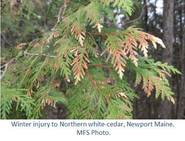 Needle Diseases of Arborvitae (Northern White-Cedar) – Observations and reports of foliage and branch tip death in northern white-cedar in natural stands and in ornamental settings have been received this spring. The most obvious symptom seen includes a “bleaching” of the tip-most foliage, which gradually changes to lighter yellow and then to brown in foliage more proximal to the main stem. Trees of any age or size may show the symptoms, including trees in natural stands remote from roadways. Examination of samples from Augusta, Norridgewock, and Newport has not revealed any insect or disease agent. The likely cause is cold temperature stress or freezing, from the extended cold periods experienced this past winter. Symptoms appear to be quite widespread in central Maine, and likely occur elsewhere in the state.
It is important to keep in mind that several insects and diseases of arborvitae can lead to similar symptoms of needle browning and death. Kabatina juniperi and Phomopsis juniperovora are two tip blight-causing pathogens more commonly found on species of Juniperus (eastern redcedar, common juniper, and Rocky Mountain juniper). Both pathogens can also occur on arborvitae. Each can cause dieback of the branchlet to about four inches from the tip. The fungi will produce small black fruiting structures (pycnidia for Phomopsis, or acervuli for Kabatina) at the juncture between the living tissue and the infected tissue of the branchlet. The infected tissues often become a dull grayish color. Several insect species can also mine the tiny branchlets, and create similar foliage symptoms. Examination of the stem tissue for tunneling and frass can help in making a correct diagnosis, even if the insects themselves are no longer present. In most cases, damage from the tip blights is primarily a loss of aesthetic quality, especially following abnormally wet springs and summers; direct tree mortality is rare.
Seed Production – A heavy seed crop was noticed in red and silver maples in southern Maine this month. It may become more apparent further north as the season progresses. Heavy seed production can lead to reduced radial growth in the year it occurs. More prominent is the thin and off-color appearance of the crown, both from reduced foliage and from the presence of fruit. A heavy seed year in desirable species provides an opportunity to reschedule harvest activities to promote regeneration
|
 White Pine Needle Diseases – One-year-old needles of white pines infected with any one of the several needle diseases prevalent during the past several years will begin to appear yellowish-brown to tan and start to be shed from affected trees within the next two weeks or so. The great majority of infections are caused by the brown spot fungus, Lecanosticta acicola (= Mycosphaerella dearnessii), but several other fungal pathogens may also be present. Heavy needle shedding is expected to last throughout the month of June, and should be largely completed by the first week in July. Affected trees will appear thin in the crowns, as the current-season needles emerging from the buds will not yet be fully expanded.
In white pine stands that have a known history of several consecutive years of needle loss, the recommendation remains to manage carefully, and avoid thinning or other disturbance-related activities that could further weaken trees. Current-season needles of ornamental white pines may be protected from infection with a foliar fungicide application of copper or chlorothalonil. Applications should be made shortly after budbreak (about the first week in June), and again two weeks later, to protect the fully-elongated needles.
White pine needle disease infection levels appear to be highly regulated by wet weather; long periods of damp weather and high rainfall increase the probability of infection. The trend so far this season has been a more “normal,” drier spring than in past years. Infection levels this year, and subsequent needle drop in 2016 may be slightly abated, but only time will tell
|
Calendar
June 19th, 2015: Rehabilitation Silviculture for Small Woodlots – Windsor, ME. William Ostrofsky will be speaking on Beech Bark Disease, along with several other speakers covering topics including American Chestnut Restoration, Pine/Oak Management, and Harvesting/BMP Considerations. The field tour is hosted by the Maine Society of American Foresters (MeSAF), and the Small Woodland Owners Association of Maine (SWOAM). See the “2015 Field Tours” link from the MeSAF home page (www.mesaf.org). Registration required.
July 10th, 2015: Hemlock...Take it or Leave it? – Orono/Grand Lake Stream, ME. Allison Kanoti will be part of a team of speakers on hemlock at this Maine Society of American Foresters (MeSAF) field tour hosted by the Downeast Lakes Land Trust and Baskahegan Company. More information and registration details are available on the “2015 Field Tours” link from the MeSAF home page (www.mesaf.org). Registration required.
July 22, 2015: Forest Pest Outreach Training – Whitneyville, ME. The MeDACF Forest Pest Outreach Project and its partners are offering a workshop to train people to recognize, report and spread awareness about the Asian longhorned beetle (ALB), emerald ash borer (EAB), and hemlock woolly adelgid (HWA) and other invasive tree pests. Three continuing education credits are available for licensed foresters and pesticide applicators. For more details see: www.maine.gov/alb under “What’s new?” in the right hand column. Registration requested—Contact Lorraine Taft at lorraine.taft@gmail.com or (207) 832-6241.
May guide to pest management in Maine contact patti.roberts@maine.gov to request an electronic or paper copy.
Conditions Report No. 2, 2015
Contributors: Charlene Donahue, Allison Kanoti, Kate Locke (Forest Inventory & Analysis), William Ostrofsky, Jan Santerre (Forest Policy & Management), Colleen Teerling, Maine CDC
|